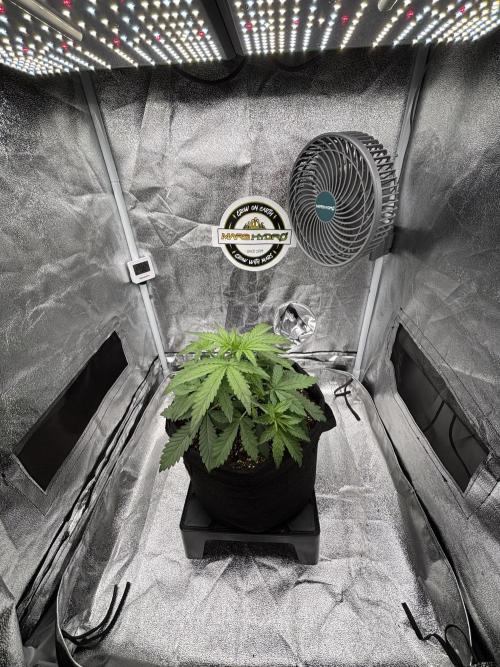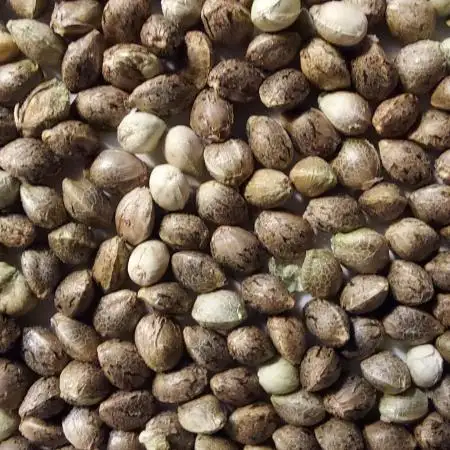The Grow Awards 2026 🏆 










Wie am besten Trainieren?
OrionGrowgulstarted grow question 4mo ago
Ich habe hier eine Lemon Cherry Cookies die ich am besten auf die breite des Zeltes ziehen möchte. (60x60).
Wann fange ich an?
Welche Methode ist die beste?
Habe mir für Später schon ein Scrognetz besorgt.
growdiaries.com/diaries/280180-grow-journal-by-oriongrowgul
Solved
Techniques. LST
likes
HandsomeTerpzanswered grow question 4mo ago
In an 80×80 cm grow tent,
a single autoflower plant can completely fill the space if trained correctly.
Since autoflowers have a fixed life cycle (8–12 weeks), you should avoid topping and mainlining.
Instead, use Low Stress Training (LST) and a SCROG net to maximize canopy coverage.
Early veg (day 10–14)
Gently bend the main stem sideways and tie it down to the pot edge.
This exposes the side branches to light, making them grow upward more evenly.
Continue LST (until ~week 4)
Tie each side branch outward, letting the plant spread across the space.
Goal: a flat, even canopy.
Set up the SCROG net
Place the net about 25 cm above the pot.
Guide branches into empty squares until the net is 70–80 % full.
Flowering stage (week 4–5 onwards)
As pistils appear and stretch begins, gently continue weaving branches.
Stop bending once stretch is over just let colas rise.
Remove small, weak growth below the net (light lollipopping).
Environment & light
Keep lights on 18/6 hours throughout.
Flower PPFD: 500–700.
Temp: 24–26 °C day / 19–21 °C night.
Humidity: 55–65 % veg → 40–50 % flower.
This approach lets one autoflower perfectly fit an 80×80 tent.
You’ll get a bushy plant with many evenly sized colas, fully filling the net and making the most of your light.
00110001001001111Oanswered grow question 4mo ago
When it takes up roughly half the area, you should have enough growth after flip to fill it out.
Scrogs are great for systematically distributing growth. Use it to train the plant out horizontally until half the squares area filled (not with a branch but with canopy coverage). Then, let it grow vertically which is also when you flip to flower. prune off axillary growth below the scrog, but keep the leaves unless it causes congestion.
You probably want to use the scrog a bit sooner in future. Easier to keep something bent down as opposed to trying to bend that dominant branch down 4-6" under the scrog. As long as it's still bendable, it shouldn't be a problem. The branches do become more rigid with age (of that branch, not applied to new growth, obviously).
As far as how many primary colas to grow vertically.. i'd shoot for 3 colas per sq ft. More will not increase yield. It'll just distribute same yield into smaller buds.
Best method? top, lst, doesn't matter if efficient and systematic about it. I prefer topping because i can more precisely posistion branches and where they will grow out etc... IF it all comes from a 'spine' of LST, then some branches have to grow a lot longer than others despite having roughly he same vege time to grow. So something is going to be short or over-grown and that means pruning off more wasted growth to avoid congestion or to comensate for different length primary branches. 'something' has to reach the sides and corners, right?
If you want to save time/electricity, go with more plants. This will shortend vege time required to fill the space. Still same guidelines.. fill half, flip to vege.
You have ~4 weeks of strong vege growth after flip to flower. Depending on your local growth rate, you may want to flip sooner or later relative to 50% of the area filled. This takes a little trial and error and depends heavily on your local variables. Slower growing may want to get to ~2/3rds filled then flip.. train the rest of the horizontal space and let it go vertiaclly... faster growth may require more training after flip to flower. Then, you got genetic diversity, lol...
So, the rules are more guidelines. Adapt to reality above all else.
symmetcial plants and square spaces are easy to train than oblong or asymmetrical plants. Can't always do that, though. e.g. if you do two plants it's going to be rectangular in shape instead of square.
Have a goal for the canopy... work backward from there to devise a plan to reach that goal in the most effective way with the least amount of wasted growth. it may take a couple cycles to have the familiarity to do it well. Even so, it's difficult to guess which plants are big stretchers and which are not. mitigate big stretchers by continuing horizontal training deeper into flower than a plant that doesn't stretch as much.
Keep that canopy even.... understand how to manipulate apical dominance... easy-peasy.
likes
Complain
GoodWeedBerlinanswered grow question 4mo ago
Gut gewählter Zeitpunkt um nachzufragen, bei der Pflanze würde ich zwischen jetzt und in ein paar Tagen mit dem LST anfangen.
Im ersten Schritt würde ich mich nur um den Haupttrieb kümmern. Meiner Erfahrung nach ist das Risiko die Pflanze zu verletzen am kleinsten, wenn der Haupttrieb nicht von der Seite gezogen wird. Entsprechend massiere ich Stelle an welcher sich die Pflanze biegen soll (bei mir meist 3.-4. Blattpaar), biege sie und stecke ein stabiles Stück Draht (aufgedrehter Kleiderbügel o.ä.) mit einem zurechtgebogenen Haken an der Spitze (ähnlich wie ein langer Zelthering) so neben die Pflanze (sollte tief in den Topf gehen damit es hält), dass ich die Spitze einhaken kann. So kommt der Druck nur von oben. Dann würde ich 5-10 Tage warten bevor du weiter trainierst. Da kannst du dann absehen wie sich die Seitentriebe verhalten und trainierst nicht "in die falsche Richtung". Wobei du schon schauen (und nachhelfen) kannst, dass der Haupttrieb nicht zu schnell wieder nach oben schiesst.
Die Seitentriebe binde ich dann später meist am Topfrand fest. Da aber auch ich ein Scrognetz benutze ist es am Ende dann meist dieses mit dem ich im letzten Schritt die Fläche vollbekomme.
Es gibt tausend richtige Arten des LST, meine ist meist so.
likes
Complain
Mooncatanswered grow question 4mo ago
Wie schon beschrieben Toppen dann lass die Äste auswachsen und binde diese gleichmäßig runter. Nimm dafür am besten einen stabilen Gartendraht mit Gummiüberzug. (Aber nicht das dünne Zeug, das schneidet nur in die Pflanze)
Am sichersten wäre aber, wenn du bei LST bleibst, weil das eine Auto ist. Wenn was schiefgeht, hast du eventuell keine Zeit mehr Fehler zu korrigieren, ohne dass die Ernte weniger wird.
Viel Erfolg Growmie
likes
Complain
Antifameanswered grow question 4mo ago
Eine sehr schöne Trainingsmethode ist das "Mainlining". Schau Dir doch mal dieses Video dazu an:
https://youtu.be/3vWL756OrMw
Es ist alles bis ins letzte Detail erklärt.
Ich habe mit LST schon ein schönes Ergebnis erzielen können und habe quasi in der ersten Woche der Wachstumsphase damit angefangen die Pflanzen in die gewünschte Form zu "zwingen". Mit Pflanzendraht, Metalbügeln oder Schnüren lassen sich tolle Formen verwirklichen. Das Scrognet kannst Du in einer späteren Phase gut dafür nutzen, der Pflanze eine gute Verteilung im Zelt zu geben.
Sei vorsichtig, aber mutig und probiere dich aus! Mache Fehler und lerne aus ihnen. Nur so wirst Du besser. 😊
Viel Erfolg und ich hoffe das hilft Dir weiter! 😘
likes
Complain
Ultravioletanswered grow question 4mo ago
Top early, break apical dominance whilst encouraging cell elongation through high transpiration with a combination on the lower side of optimal ppfd with a squirt of extra red/far reds.
Once broken every stem will grow to reach the apex as the hormone balance will be altered, the plant will now naturally grow like a candelabra rather than a evergreen tree.
Don't necessarily needs a Scrogg net a trellis net would be just as useful to fill that space. Then again if height is going to be an issue a Scrogg may be preffered choice.
To get a solid idea of how and what I mean have a peek at my latest diary. Sol, will show you how to spread a plant across a space in the most efficent manner possible (I could find) given you have the height to play with. Once you get the canopy where you want you can lay off the reds, increase ppfd and lower environmental metrics to ease up on transpiration. This will slow vertical growth just long enough that every side stem will grow to roughly same height. Once you get it level and how you want you release her into flower.
By no means the best or only method jist one I prefer.
Gluck growmie.
Genetics loads the gun, environment pulls the trigger. Co-create.
2 likes
Complain
Sanabassananswered grow question 4mo ago
Du solltest sie dann schon mal toppen. Und wenn die Seiten trieben wachsen sie dann nach unten biegen .
1 like
Complain
Similar Grow Questions
Solved

PoleKat
Switching to flowering nutrients (autoflower)Just wondering if anyone has any ideas as to when I should start switching these critical purple autoflowers to flowering nutes? As I understand it should be a few weeks after preflowers start? Hard to tell when vertical growth slows when doing LST. This is my first grow ever!
6y ago
3
Solved

shiptony
LSTAny tips on how to better shape the plant when doing LST?Week 5
Techniques. LST
5y ago
3
4
Solved

dirrii
first grow and first lst and i need some helpthis is my first grow and first lst try. she is 3 weeks old. i think she is little bit short but its ok. if the point is trying give her light to everywhere on her, is it correct to what i do? i m waiting your support and pls dont laugh at me :) i told it is my first time :)
Plant. Too short
Techniques. LST
5y ago
3
3
Solved

delta_420
Accidentally bent/squished the stem on Pheno #3, is it possible it can bounce back?I was LST'ing the Purple Haze Pheno #3, I accidentally got a bend in the stem and it could have snapped or partially torn, I attached some photos hope these help. It was by accident, I have nerve damage and arthritis so I can't keep my hands still that much especially standing.
2y ago
1
1
Solved

TupacFR
Apex brokenHello ,
I broke my apex while doing LST, is it bad or will it grow back?
Thanks
Plant. Other
Techniques. LST
4y ago
1
Solved

xHSxMonki
Low stress training. To undo and redo or leave them as is. That the question :PAnother one related to my lst.
So i got the hang of doing lst. I started off really early with all on the lst. The plant is fairly close to the ground. Can I undo the lst and let them grow a bit tall and then re do the lst later? Or leave it as it is and let them grow as is?
Week 4
Techniques. LST
6y ago
2





























